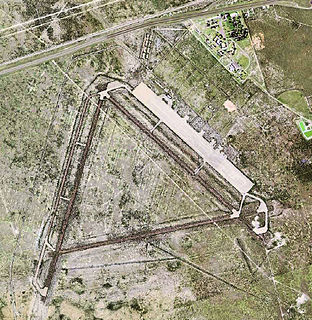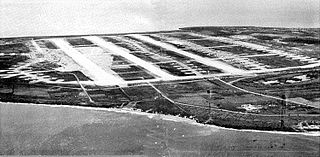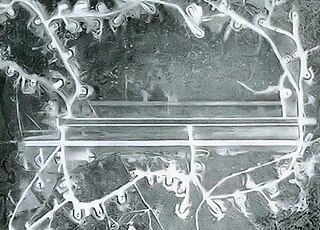| Ar Rumaylah Southwest Air Base | |
|---|---|
| Coordinates | 30°21′21″N047°06′36″E / 30.35583°N 47.11000°E |
Ar Rumaylah Southwest Air Base is an Iraqi Air Force base in the Basra Governorate of Iraq.
| Ar Rumaylah Southwest Air Base | |
|---|---|
| Coordinates | 30°21′21″N047°06′36″E / 30.35583°N 47.11000°E |
Ar Rumaylah Southwest Air Base is an Iraqi Air Force base in the Basra Governorate of Iraq.
Ar Rumaylah Air Base was a primary air base for the Iraqi Air Force. At each end of the main 10,000-foot runway are a dozen hardened aircraft shelters (HAS), also known as "Trapezoids" or "Yugos" which were built by Yugoslavian contractors some time prior to 1985 with multiple runways and taxiways, patterned after their Russian counterparts.
At around 9:30AM on January 17, 1991 (the first day of Operation Desert Storm), an 8 ship formation of R.A.F. GR.1 Tornados flying from Tabuk Airfield in Saudi Arabia, attacked Ar Rumaylah Southwest in the first Tornado daylight strike of the war. [1] They each carried eight 1,000 Ib bombs to attack the HASs in a toss delivery attack. [2] [3] The attack occurred in conjunction with a US Marines Corps SEAD package of 24 F/A-18 Hornets and 2 EA-6B Prowlers which were attacking SA-6s to the east of the Ar Rumaylah.
During the attack, only 2 aircraft (The lead and No.4 aircraft) were able to drop their bombs, in this case, on the southern HAS site, flying at 600 kts. They also encountered heavy AAA fire during the toss attack. After the attack, the No.2 aircraft (ZD791), crewed by Flt Lt. John Peters and Flt Lt. John Nichol, were hit by an SA-16 IR SAM and were able to eject from their stricken jet. They were then captured and became P.O.W.s. [4] [3] [5] The lead aircraft was also locked on by Roland and SA-8 missile launchers. [2]
The base would be heavily attacked by Coalition air power during the rest January 1991, and seized by the U.S. 3rd Armored Cavalry Regiment in February 1991. It was abandoned by the Iraqi Air Force after the cease fire in late February.
It was again captured by Coalition forces during the 2003 invasion of Iraq. [6]
Current aerial imagery shows that the operational structures around the airfield appear to have been demolished and removed. Today the concrete runway and series of taxiways remain exposed and deteriorating to the elements, being reclaimed by the desert.

Nichols Field was a U.S. military airfield located south of Manila in Pasay and Parañaque, Metro Manila, Luzon, the Philippines. The complex is located at Andrews Avenue by the north, Domestic Road by the west, NAIA Road and Ninoy Aquino Avenue by the southwest, Multinational Avenue by the south, South Luzon Expressway and the Metro Manila Skyway by the east, and Sales Street by the northeast.

Pyote Air Force Base was a World War II United States Army Air Forces training airbase. It was on 2,745 acres (1,111 ha) a mile from the town of Pyote, Texas on Interstate 20, 20 miles west of Monahans and just south of U.S. Highway 80, 230 miles (370 km) east of El Paso.

Number 15 Squadron, sometimes written as No. XV Squadron, was a squadron of the Royal Air Force. It most recently operated the Panavia Tornado GR4 from RAF Lossiemouth as No. XV (Reserve) Squadron. It was the RAF's Operational Conversion Unit for the Tornado GR4 which taught pilots and Weapon Systems Officers (WSO) how to fly the aircraft and what tactics to use to best exploit the performance of their aircraft and its weapons.

A hardened aircraft shelter (HAS) or protective aircraft shelter (PAS) is a reinforced hangar to house and protect military aircraft from enemy attack. Cost considerations and building practicalities limit their use to fighter size aircraft.

Royal Air Force Chelveston, or more simply RAF Chelveston, is a former Royal Air Force station located on the south side of the B645, 5 miles (8.0 km) east of Wellingborough, near the village of Chelveston in Northamptonshire, England. During the Second World War the airfield was occupied by both the Royal Air Force and the United States Army Air Forces. It was given the USAAF designation Station 105.

Royal Air Force Metfield or more simply RAF Metfield is a former Royal Air Force station located just to the southeast of the village of Metfield, Suffolk, England.
Squadron Leader Paul Mason, known as Pablo Mason, is a retired Royal Air Force pilot, who was part of the XV Squadron detachment to Bahrain as part of the RAF Tornado squadron during the Gulf War, and subsequently wrote about his experiences. Mason is known for his handlebar moustache, and his Biggles-like attitude and persona.

North Field is a former World War II airfield on Tinian in the Mariana Islands. Abandoned after the war, today North Field is a tourist attraction. Along with several adjacent beaches on which Allied forces landed during the Battle of Tinian, the airfield is the major component of the National Historic Landmark District Tinian Landing Beaches, Ushi Point Field, Tinian Island.

The Port Moresby Airfield Complex was a World War II military airfield complex, built near Port Moresby in the Territory of Papua and New Guinea. It was used during the Battle of New Guinea as a base of Allied air operations primarily in 1942 and early 1943. It later became a support base as the battle moved to the north and western part of New Guinea. It was closed and the facility turned over to civil authorities after the end of the war in September 1945.

Chateaudun-du-Rhumel Airfield is an abandoned military airfield in Algeria, located about 6 km north-northwest of Chelghoum el Aid, in Mila province, about 47 km southwest of Constantine.
Enfidaville Airfield is an abandoned World War II military airfield in Tunisia, located approximately 13 km north-northwest of Harqalah; approximately 90 km southwest of Tunis. It was used by the United States Army Air Force Twelfth Air Force during the North African Campaign as a B-24 heavy bomber and troop carrier base. Known units assigned were:

The Foggia Airfield Complex was a series of World War II military airfields located within a 40 km (25 mi) radius of Foggia, in the Province of Foggia, Italy. The airfields were used by the United States Army Air Force Fifteenth Air Force as part of the strategic bombardment campaign against Nazi Germany in 1944 and 1945, as well as the Twelfth Air Force, the Royal Air Force and the South African Air Force during the Italian Campaign (1943–1945).

Saint-Simon – Clastres Air Base is an abandoned military airfield, which is located approximately 3 km (2 NM) northwest of Clastres and east of Saint-Simon, both communes in the Aisne department of the Picardy (Picardie) region in France. It is approximately 116 km (63 NM) north-northeast of Paris.
Juvincourt Airfield is an abandoned military airfield, which is located near the commune of Juvincourt-et-Damary in the Aisne department of northern France.
Laon-Athies Air Base is an abandoned military airfield, which is located near the city of Laon in the Aisne department of France.
Valenciennes-Denain Airport is a regional airport in France, located southwest of Valenciennes ; 115 miles (185 km) north-northeast of Paris
Eschborn Airfield is an abandoned military airfield in Germany located approximately 10 km northwest of Frankfurt am Main (Hessen) and 435 km southwest of Berlin.

H-2 Air Base is a former Iraqi Air Force base in the Al-Anbar Governorate of Iraq. It was captured by U.S.-led Coalition forces during Operation Iraqi Freedom in 2003.

H-3 Air Base is part of a cluster of former Iraqi Air Force bases in the Al-Anbar Governorate of Iraq. H3 is located in a remote stretch of Iraq's western desert, about 435 kilometers from Baghdad in western Iraq. It is close to the Syrian–Iraqi border, and near the highway that connects Jordan with Baghdad.

Shaibah Air Base is an Iraqi Air Force airfield in the Basrah Governorate of Iraq.